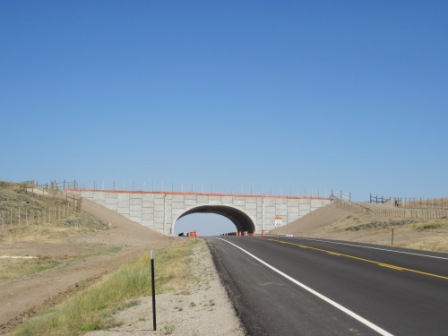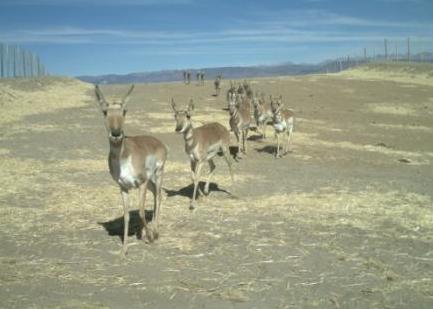A series of underpasses and overpasses recently completed along a Wyoming highway has improved safety for the traveling public while preserving an historic wildlife migration route for pronghorn antelope and mule deer. Completed in October 2012, the Trappers Point project included design and construction of two overpasses and six underpasses on a 12-mile section of US 191, west of Pinedale.
Each overpass consists of a long-span precast-concrete arch culvert constructed over the highway to provide an artificial tunnel over which wildlife can cross safely. The culverts are surrounded by earth berms supported on each end by large precast-panel retaining walls. The project also includes about 30 miles of special fencing to direct animals to the safe crossings.
Historic Migration Route
In an area known as the Upper Green River Valley corridor, pronghorn travel between their winter range in the high desert, south of Pinedale, and their summer range in Grand Teton National Park. The corridor, which represents the second-longest wildlife migration route in the Western Hemisphere, intersects with US 191 at Trappers Point.
The Trappers Point area was named for the nineteenth-century fur trappers who took advantage of natural terrain that bottlenecks the migratory herds. In modern times, it had become the site of frequent vehicle collisions with pronghorn, mule deer, and other animals.
Seeking to address this concern, a collaborative effort between WYDOT and a number of state and federal agencies and other organizations identified key locations where wildlife crossing structures could be beneficial. To facilitate the passage of pronghorn – which are reluctant to use traditional wildlife underpasses – WYDOT committed to build its first-ever wildlife overpasses.

Trappers Pond Wildlife Crossing. Photo: Wyoming DOT
Locations for the various crossing structures were chosen based on areas with the highest instances of motor vehicle collisions, observations by local game and fish and WYDOT personnel, and studies of the movement of collared antelope and deer. The agencies also considered the terrain, as well as already-preserved movement corridors, such as public lands or conservation easements.
Development of the wildlife connectivity plan for the area was a collaborative effort that included the Wyoming Game and Fish Department, the U.S. Forest Service, the Bureau of Land Management, the U.S. Fish and Wildlife Service and the Federal Highway Administration. It also incorporated wildlife research from organizations including the National Fish and Wildlife Foundation, the Biodiversity Conservation Alliance, the Greater Yellowstone Coalition, the Wyoming Outdoor Council, the Rocky Mountain Elk Foundation, and National Geographic.
Focus on Highway Safety
The agencies initially collaborated in an effort to obtain funding for the project under the American Recovery and Reinvestment Act. When that funding fell through, WYDOT was able to continue the effort by stressing the importance of highway safety: the combined loss of wildlife and property damage to vehicles was estimated at nearly $4.1 million from 2005 through 2009.
Under the focus of highway safety, WYDOT was able to secure the National Highway System federal funds to advance the project, according to Tim Stark, Environmental Services Engineer with WYDOT. The funds are expected to provide a valuable return. According to WYDOT, “The savings from reducing wildlife deaths and damage to vehicles is expected to exceed the project cost of $9.7 million in 12 years.”
Monitoring Shows Promising Results
The project already has proven to be beneficial for thousands of animals that have found their way safely across the highway. The most recent monitoring, conducted between Oct. 1 and Dec. 15, 2012, used remote cameras to document 8,878 mule deer and pronghorn moving through the new crossing structures.

Wildlife crossings help pronghorn safely cross the highway. Photo: Wyoming DOT
These results were particularly encouraging by demonstrating pronghorn’s use of the overpasses. Of the 8,878 animal crossings, 2,442 were pronghorn and 6,436 were mule deer. While most mule deer moved through the underpasses, 92 percent of the pronghorn used the overpasses. “The Trappers Point overpass is so well designed and so well suited to accommodate pronghorn migration, that we observed pronghorn using the overpass even before completion,” Jeff Burrell, Northern Rockies program coordinator for the Wildlife Conservation Society, said in a release. Stark said WYDOT will consider lessons learned from the Trappers Point project in planning for future efforts to ensure the safety of travelers and wildlife.
The Trappers Point project has received numerous awards, including the Wyoming Engineering Society’s 2012 President’s Project of the Year and the Federal Highway Administration’s 2011 Exemplary Ecosystem Initiative award. A National Geographic video featuring the project also is posted on the WYDOT website.
For more information on Trappers Point and other wildlife protection projects, visit the WYDOT Wildlife and Fisheries website, or contact Tim Stark, WYDOT Environmental Services Engineer, at [email protected] or by phone at 307-777-4279.